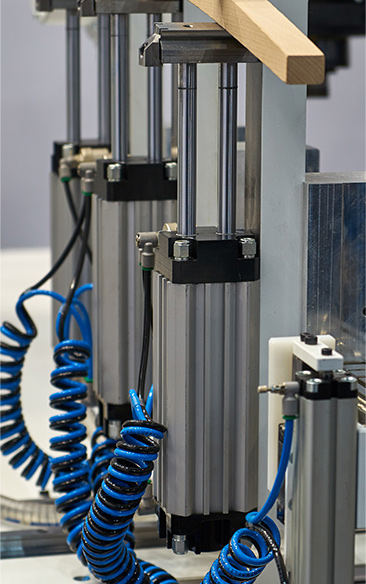What Is Servo Pneumatics?
Post By: Ryan King On: 23-06-2020 Read Time: 5 minutes - Guides - Pneumatics
Post By: Ryan King On: 23-06-2020 Read Time: 5 minutes - Guides - Pneumatics
A servo mechanism or actuator is defined as any kind of closed-loop mechanism that provides feedback to correct the position of the actuator. Such an actuator may be of any type, including pneumatic, hydraulic or electric, provided it supplies negative feedback via an error-sensing transducer. This allows the actuator to correct any positional error automatically and with great precision.
A basic or “bang-bang” pneumatic actuator is one that creates rotary or linear motion using compressed air. It derives its name from the simple back and forth action of a single stroke piston, which traditionally would “bang” from one end to the other. Such old-style cylinders had no flexibility in their movement profile, and no ability to regulate the amount of force applied. To convert a simple pneumatic cylinder into a servo pneumatic actuator required only the addition of a reed sensor and a directional control valve. This then enabled the actuator to adjust its position in response to the negative feedback received from the sensor.

Any type of servo system needs a controller and a feedback device to monitor errors of speed, position, or torque-force, and to correct them. The servo pneumatic device simply represents the integration of a pneumatic actuator or cylinder with that feedback and control system. A crucial component of such a modern servo pneumatic system is provided by a proportional valve. This can regulate air delivery with great precision to ensure that the required force or position is achieved.
Originally, pneumatics offered a simple, cost-effective solution for very basic point-to-point actions. Applications requiring a more expensive, higher-precision solution would opt for a servo-controlled electromechanical actuator for advanced positioning, accuracy, and force-torque. Servo pneumatics are the ideal medium between these two extremes. The closed-loop system offers a relatively high degree of control, but is nowhere near so costly or complex as an electromechanical servo system.
Traditional pneumatics provided rapid point-to-point motion at high force. Servo pneumatics offer the same capabilities in force and speed, but have the added advantage of greater positioning accuracy via the negative feedback loop. This applies not only to the position of the actuator at each end of the stroke, but to points in between along the trajectory of the piston. Servo pneumatics also monitor and regulate the system's air pressure, controlling the air supply and flow according to the required force and position of the actuator, and enabling more precise force-torque control.
The servo pneumatic cylinder does not fully exhaust the compressed air during its operation, thus enabling a reduction in air consumption of up to 30% over standard pneumatic systems. Traditional pneumatics are (or are perceived to be) hampered by their heavy air consumption. The preparation and delivery of compressed air costs money, and traditional pneumatic systems can continue to use significant quantities of air even when not in operation. On the other hand, it should be noted that servo pneumatics demand a higher quality of air to ensure constant precision operation. It's usually recommended that servo pneumatic systems install a 5-micron filter, as well as the industry-standard filtration units.
Electromechanical servo systems have been preferred for a long time over pneumatics, because of their greater control of force and accurate positioning. Air compression is a much more difficult variable to define and model than the typical problems encountered in an electromechanical system, such as compliance and backlash.
In the last decades, however, advances in control technology have encouraged the adoption of servo pneumatics in many industrial applications. This is generally because they have a much higher power density, or ratio of available force to actuator size. Applications that rely on inserting, pressing and tightening motions find significant advantage in the smaller size requirements of a servo pneumatic actuator or cylinder. Compared to an electromechanical actuator of comparable body size, servo pneumatics provide a far greater force capability.
Servo pneumatics also require less input power, commonly operating on 24v DC power supplies. This makes them a better choice for low-power applications and helps reduce thermal build-up through heat generation. Servo pneumatics therefore perform well in high-temperature environments and continuous-duty applications.
Servo pneumatics have really come into their own in the last decade or so, with the development of technology that could deal with the non-linearity of air compression control. The recent development and integration of digital signal processors and high-response control valves have enabled pneumatic control algorithms to be created which can take these variables into account. These algorithms are capable of performing the high-speed computations that make servo pneumatic systems workable.
If top speed and pinpoint precision are not your top priorities, and you already have compressed air, there are many advantages to choosing a servo pneumatic actuator, including:
Servo pneumatic systems are ideal for pressing applications, where control and flexibility are required to produce workpieces using a defined force. Two examples are the feeding of variable width and thickness wooden slats into a high-speed saw, or sheet metal forming in the automotive industry.
In dosing technology, servo pneumatic systems are ideal for the control of volume filler systems. They can also be used in test engineering for the positioning of test equipment.
Servo pneumatics can be used in conveying and packaging technology for pushing and sorting functions, and for gripping objects of all sizes and shapes. They can be programmed to pass items from a conveyor belt to a unit for packaging, as well as for package labelling.
As industrial automation becomes ever more sophisticated with the advance of Industry 4.0, the uses of servo pneumatics will continue to become more widespread and varied.